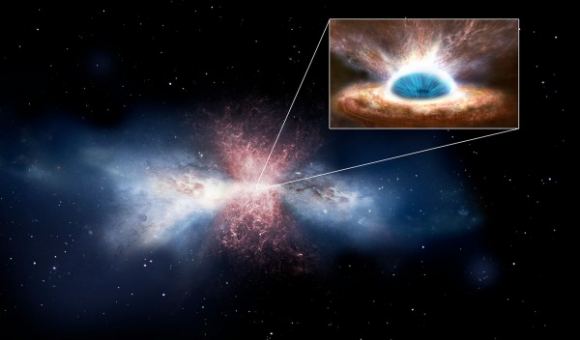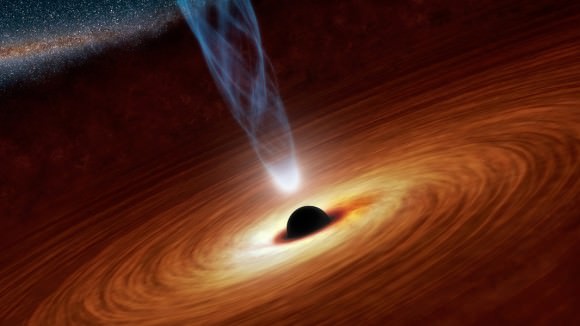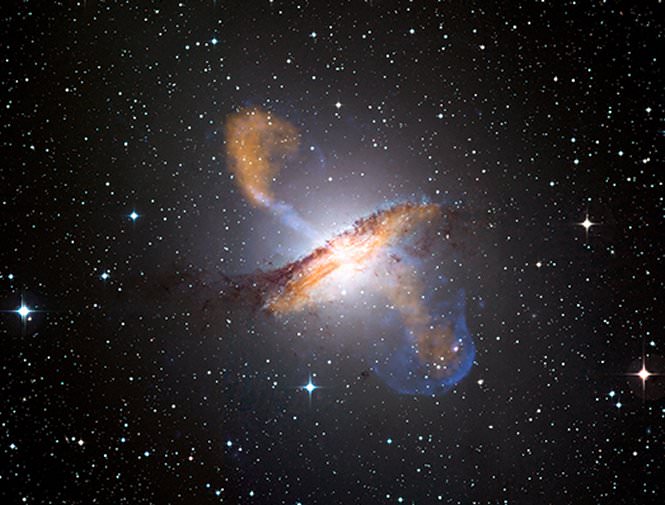During the 1960s, scientists discovered a massive radio source (known as Sagittarius A*) at the center of the Milky Way, which was later revealed to be a Supermassive Black Holes (SMBH). Since then, they have learned that these SMBHs reside at the center of most massive galaxies. The presence of these black holes is also what allows the centers of these galaxies to have a higher than normal luminosity – aka. Active Galactic Nuclei (AGNs).
In the past few years, astronomers have also observed fast molecular outflows emanating from AGNs which left them puzzled. For one, it was a mystery how any particles could survive the heat and energy of a black hole’s outflow. But according to a new study produced by researchers from Northwestern University, these molecules were actually born within the winds themselves. This theory may help explain how stars form in extreme environments.
The study recently appeared in The Monthly Notices of the Royal Astronomical Society under the title “The origin of fast molecular outflows in quasars: molecule formation in AGN-driven galactic winds.” The study was conducted by from Northwestern University’s Center for Interdisciplinary Research and Exploration in Astrophysics (CIERA).

For the sake of their study, Richings developed the first-ever computer code capable of modeling the detailed chemical processes in interstellar gas which are accelerated by a growing SMBH’s radiation. Meanwhile, Claude-André Faucher-Giguère contributed his expertise, having spent his career studying the formation and evolution of galaxies. As Richings explained in a Northwestern press release:
“When a black hole wind sweeps up gas from its host galaxy, the gas is heated to high temperatures, which destroy any existing molecules. By modeling the molecular chemistry in computer simulations of black hole winds, we found that this swept-up gas can subsequently cool and form new molecules.”
The existence of energetic outflows form SMBHs was first confirmed in 2015, when researchers used the ESA’s Herschel Space Observatory and data from the Japanese/US Suzaku satellite to observe the AGN of a galaxy known as IRAS F11119+3257. Such outflows, they determined, are responsible for draining galaxies of their interstellar gas, which has an arresting effect on the formation of new stars and can lead to “red and dead” elliptical galaxies.
This was followed-up in 2017 with observations that indicated that rapidly moving new stars formed in these outflows, something that astronomers previously thought to be impossible because of the extreme conditions present within them. By theorizing that these particles are actually the product of black hole winds, Richings and have managed to address questions raised by these previous observations.

Essentially, their theory helps explain predictions made in the past, which appeared contradictory at first glance. On the one hand, it upholds the prediction that black hole winds destroy molecules they collide with. However, it also predicts that new molecules are formed within these winds – including hydrogen, carbon monoxide and water – which can give birth to new stars. As Faucher-Giguère explained:
“This is the first time that the molecule formation process has been simulated in full detail, and in our view, it is a very compelling explanation for the observation that molecules are ubiquitous in supermassive black hole winds, which has been one of the major outstanding problems in the field.”
Richings and Faucher-Giguère look forward to the day when their theory can be confirmed by next-generation missions. They predict that new molecules formed by black hole outflows would be brighter in the infrared wavelength than pre-existing molecules. So when the James Webb Space Telescope takes to space in the Spring of 2019, it will be able to map these outflows in detail using its advance IR instruments.
One of the most exciting things about the current era of astronomy is the way new discoveries are shedding light on decades-old mysteries. But when these discoveries lead to theories that offer symmetry to what were once thought to be incongruous pieces of evidence, that’s when things get especially exciting. Basically, it lets us know that we are moving closer to a greater understanding of our Universe!
Further Reading: Northwestern University, MNRAS




